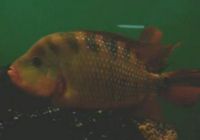Red Terror (Cichlasoma festae)
From The Aquarium Wiki
Red Terror
Cichlasoma festae
473 Litres (125 US G.)
30.5-45.7cm (12-18 ")
Freshwater
7.0 - 7.5
26 -28 °C (78.8-82.4°F)
8-15 °d
1:1 M:F
8-10 years
Family
Cichlidae
| You can contribute to the Aquarium Wiki by expanding this article. Dont be shy!. |
Contents
Additional names
- Red Terror, Guayas Cichlid
Additional scientific names
- Heros festae, Herichthys festae, Nandopsis festae
Origin
|
|
This section requires expansion with: Location where this animal is found in the wild. |
Sexing
- Festae are generally not sexable until approximately 3.5-4" or larger. The black vertical bars of males will fade and typically will not show unless the fish is showing aggression or during breeding. The body colour of the male is more of a light orange to yellow and the male will have blue spangles on the body and in the finnage. The dorsal and pelvic fins are red. Females, on the other hand, will show solid black vertical bars nearly all of the time. The body colour will be more of a deep orange to bright red. Dorsal and pelvic fins will have black or dark blue colouration covering part or all of the fins.
Tank compatibility
|
|
This section requires expansion with: Other animals this species can be housed with, or animals they should not be housed with. |
Diet
|
|
This section requires expansion with: Details on what this species will eat.. |
Feeding regime
|
|
This section requires expansion with: Specific feeding instructions other then the standard Feeding Regime. |
Environment Specifics
|
|
This section requires expansion with: Anything the species requires to be comfortable in the tank, such as caves or grasses. |
Behaviour
|
|
This section requires expansion with: Any behaviour quirks such as gulping air, or aggressiveness.. |
Identification
- Red Terrors are commonly mistaken for Cichlasoma urophthalmus (the Mayan Cichlid). The key differences are as follows:
- Both species have a trademark 'Eye Spot' on the caudal peduncle. This spot on a festae will be comparably smaller than that of a uropthalmus. The festae eye spot will take up approximately 1/3 of the caudal peduncle whereas the uropthalmus eye spot will generally take up at least half of the caudal peduncle. Also the eye spot on the festae will be positioned at the top of the caudal peduncle whereas the eye spot on the uropthalmus is centered on the caudal peduncle.
- Both species have vertical black bars. All of the vertical bars on the uropthalmus are straight up and down. The festae, however, will have one vertical bar just behind the gill plate that forms a Y on the upper portion of the fish's body.
- As adults the red/orange colouration is typically much more vibrant on festae as opposed to the more pale pinkish body colour of an adult uropthalmus. You cannot determine the identification of the species based on this characteristic until the fish is at least 7.6-12.7cm (3-5") whereas the other 2 differences can be seen as small as 3.8-5.1cm (1.5-2").
Pictures
External links
- Fishbase (Mirrors:
 )
)
